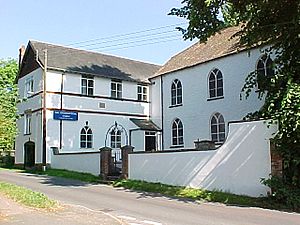Cam Congregational Church facts for kids
The Cam Congregational Church is a historic church in the village of Upper Cam, near Dursley in Gloucestershire, England. It was started in 1662 and was first known as the Cam Independent Meeting. It was the first "Nonconformist" chapel in the area. This means it was for Christians who worshipped differently from the main Church of England.
Today, the building is a Grade II Listed Building, which means it is officially recognized as a special and important historic site.
A Long and Interesting History
The first chapel building was constructed in 1702 on land given by a local cloth maker named William Hicks. The church has kept many of its old records, which are now stored at the Gloucestershire Archives. These records include meeting notes, account books from as far back as 1776, and even registers of who attended Sunday School over 100 years ago.
In June 2008, the members of Cam Congregational Church were joined by another group called the Cotswold Community Church. After this, the chapel was given a new name: 3C Community Church.
Leaders of the Church
From 1662 to 2008, the church had twenty-two official ministers.
The first minister, Joseph Twemlow, was appointed in 1702. He was very important to the community. In 1715, he started a school in his own house for poor children in the Dursley area. This school provided education for local children for 172 years. Later, it became a charity called the Twemlow Trust, which still helps young people with their education.
Over the centuries, many other ministers led the church.
- Rev John Thomas served as pastor for forty years, from 1776 to 1816.
- Rev Thomas Griffiths oversaw a major renovation of the chapel in 1818.
- Rev James Williams was the minister when a new Sweetland organ was installed in 1881. It cost £200, which was a lot of money back then.
- Rev Owen Griffiths, who became pastor in 1907, encouraged people to sign a pledge to avoid alcoholic drinks as part of the Temperance movement.
After 1990, the church was led by a team of volunteers for many years. In 2008, Noel Fellowes became the minister of the newly named 3C Community Church, and Phil Greenow took over in 2018.
The Church Building
The church is a two-story stone building with a tiled, sloping roof called a hipped roof. Inside, the walls are covered in wood panels. A U-shaped balcony, held up by decorative cast-iron pillars, runs along the upper level. At the front, there is a raised pulpit where the minister speaks.
The building has been changed and updated many times.
- In 1818, the chapel was remodelled. Pews were installed, which people could rent. A card with their name was put in a brass holder on the end of the pew.
- In 1895, new classrooms and a hall were added for the Sunday School.
- In 1995, a major renovation added a new kitchen, toilets, and a car park. The upstairs of the schoolrooms was turned into a flat for future ministers.
- In 1999, the inside of the chapel was updated again. The old pews were replaced with comfortable chairs. However, many historic features were kept, like the balcony, the pulpit, an 18th-century Parliament clock, and the Sweetland organ from 1881.
-
The central pulpit was installed in 1818.








